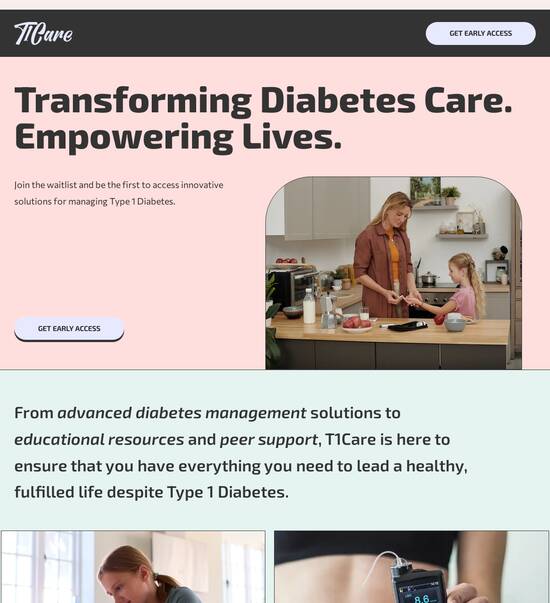
HTML page template for Test analysts
Use TemplateAbout template
Attract clients and showcase your skills with style using our landing page templates for Test analysts. Let's convert those visitors into clients!
Recommended templates

Easy to build without coding
With the intuitive drag-and-drop builder, anyone on your team can create high-converting pages without any knowledge of code or design. Make enhancements to your landing page with custom widgets using Javascript, HTML/CSS, or third-party scripts.

Multiple layouts for any industry and goal
Select from 500+ landing page layouts built to boost conversions across industry-specific scenarios. Customize them by adjusting fonts, adding images, and generating on-brand content with the AI assistant. Quickly scale with Instablocks® and Global Blocks that you can save, reuse, and update globally.

Loads fast and looks polished on any device
Every template is responsive, which means they present professionally on any device and load blazingly fast with our Thor Render Engine. You can also power them up with Google AMP technology to deliver an unparalleled mobile experience and drive higher conversions.

Robust analytics & experimentation
Get real-time updates and reporting across all your devices, showing the number of visitors, conversions, cost-per-visitor, and cost-per-lead. Launch AI-powered experiments, run A/B tests, and use heatmaps to analyze user behavior, then optimize your landing page to maximize conversions.







Easy to build without coding
With the intuitive drag-and-drop builder, anyone on your team can create high-converting pages without any knowledge of code or design. Make enhancements to your landing page with custom widgets using Javascript, HTML/CSS, or third-party scripts.
Multiple layouts for any industry and goal
Select from 500+ landing page layouts built to boost conversions across industry-specific scenarios. Customize them by adjusting fonts, adding images, and generating on-brand content with the AI assistant. Quickly scale with Instablocks® and Global Blocks that you can save, reuse, and update globally.
Loads fast and looks polished on any device
Every template is responsive, which means they present professionally on any device and load blazingly fast with our Thor Render Engine.
Robust analytics & experimentation
Get real-time updates and reporting across all your devices, showing the number of visitors, conversions, cost-per-visitor, and cost-per-lead. Launch AI-powered experiments, run A/B tests, and use heatmaps to analyze user behavior, then optimize your landing page to maximize conversions.
All the features you need to build html test template
Explore more featuresLearn how to build website test template
Frequently asked questions about test template for visual design evaluation
Leading the way in building high-performing landing pages





Web test template: Your ultimate how-to guide
Instapage stands out as the most powerful landing page and conversion rate optimization (CRO) platform available, especially for marketers in the USA aiming to maximize their digital campaign ROI. The platform allows you to optimize and accelerate your campaigns with a comprehensive suite of tools tailored for various industries.
Overview of Instapage's features
Instapage provides users with a robust collection of features that streamline the landing page creation process. These features cater to different phases of a digital marketing campaign, ensuring that marketers can effectively capture leads and convert visitors into customers. Instapage supports various industries including business services, education, and financial services.
- Templates & Lead Gen Elements: Over 100 ready-to-use templates that allow customized lead generation without starting from scratch.
- Easy-to-Use Landing Pages: A library of conversion-focused layouts enables rapid page creation without the need for a developer.
- Built-In Optimization: Experimentation features ensure continuous improvement through A/B testing and detailed heatmaps.
Creating your first landing page
Follow these steps to create your first effective landing page using Instapage:
- Select a high-converting template that aligns with your marketing goals. This enables an efficient start as you build upon proven designs.
- Utilize Instablocks to integrate unique customizations seamlessly. These blocks serve as reusable elements that help maintain design consistency.
- Incorporate lead generation forms and CTAs strategically to guide user actions effectively.
Optimizing for higher conversions
After launching your landing page, it's crucial to optimize for maximum results. Here’s how you can fine-tune your page based on real-time data:
- Implement A/B testing with different headlines or images to see what resonates best with your audience.
- Use heatmaps to track user behavior and identify areas for improvement based on how visitors interact with your content.
- Adjust your personalization features, like dynamic text replacement, to deliver customized experiences based on visitor data.
By following these steps, you can harness the full capability of Instapage, driving not just traffic but meaningful conversions.
Ultimately, testing and tweaking are fundamental to a successful landing page strategy. Utilize the platform’s collaborative features to gather instant feedback and enhance your pages effectively.
Get started with Instapage today and transform your landing pages into high-performing assets that maximize ROI and boost your marketing efforts!
People also ask about HTML page template for Test analysts
HTML page template for test analysts: A strategic asset
Understanding HTML page templates
HTML page templates serve as the backbone of any website, providing a reusable framework that test analysts can leverage for effective testing and validation. These templates encapsulate the structure and design elements of a webpage, allowing teams to implement and assess various features and functionalities with consistency and ease. For test analysts, having a well-defined HTML template can significantly streamline the testing process, enabling them to focus on quality assurance tasks without getting bogged down by repetitive coding.
The foundation of building blocks in template testing
At the core of HTML templates are their building blocks, which include essential components that come together to form a cohesive web page. These building blocks typically consist of headers, footers, navigation menus, content sections, and sidebars. Each of these elements plays a crucial role in how users interact with the website, and their modular design enhances the ease of making changes and ensuring functionality.
Headers: Provide branding and navigation links.
Footers: Offer additional navigation, contact information, and copyright details.
Navigation menus: Facilitate seamless movement through various sections of the site.
Content sections: Hold the main information and visuals that engage the user.
The importance of modular design cannot be overstated, as it allows test analysts to isolate issues, test components individually, and conduct thorough assessments before launching the entire site. This structured approach makes debugging far more manageable.
Developing robust HTML page templates for test analysts
Creating effective HTML templates requires a strategic approach tailored to the needs of test analysts. Here’s a step-by-step guide to developing these templates:
Identifying the needs of test analysts: Collaborate with stakeholders to understand their requirements and challenges.
Structuring the layout for optimal testing: Design templates that allow for easy testing of individual components.
Ensuring compatibility with various testing tools: Check that templates work seamlessly with automated testing platforms and other essential tools.
By following these steps, test analysts can significantly reduce the time and effort required for testing, leading to quicker insights and more effective outcomes.
The impact of accessibility issues on template success
Accessibility is a critical aspect of web design, and HTML templates must cater to various users, including those with disabilities. Understanding potential accessibility challenges becomes imperative for ensuring that templates deliver a positive user experience for everyone. Common pitfalls include poor color contrast, insufficient text resizing options, and ineffectual keyboard navigation.
Color Contrast: Ensure text stands out against backgrounds for readability.
Text Resizing: Allow users to increase text size without breaking layout.
Keyboard Navigation: Facilitate easy navigation for users reliant on their keyboard.
Addressing these issues not only promotes inclusivity but can also enhance overall user satisfaction and compliance with legal standards.
Navigating web content accessibility guidelines (WCAG) 2.2
The Web Content Accessibility Guidelines (WCAG) 2.2 offers a framework for making web content more accessible. Familiarity with key principles is essential for design and testing teams.
Perceivable: Ensure that users can perceive the content.
Operable: Navigation elements should be operable for everyone.
Understandable: Content should be easy to understand.
Robust: Content must work with current and future user agents.
Test analysts can utilize a checklist based on these principles to evaluate template compliance and maintain high accessibility standards effectively.
Employing accessibility experts in template development
Integrating accessibility experts into the template development process ensures that potential usability barriers are identified and addressed early on. Their expertise can guide design choices and highlight common accessibility issues that may be overlooked by developers alone.
Furthermore, collaboration between test analysts and accessibility experts fosters a continuous feedback loop where insights can be shared. By conducting joint reviews and tests, teams can enhance usability and compliance, ultimately contributing to a superior user experience.
Critical considerations in template testing
Template testing is an essential aspect of quality assurance, focusing on ensuring that templates function as expected across different browsers and devices. By defining what template testing entails and understanding its importance, teams can better prepare for the processes involved.
Functionality Testing: Verify that all components work correctly.
Usability Testing: Assess user experience and ease of navigation.
Performance Testing: Examine page load times and responsiveness.
Incorporating a systematic approach to these testing types will enhance the quality of the templates produced.
Identifying common issues during template testing
During template testing, teams often encounter common issues, including rendering problems, slow loading speeds, and inconsistencies across browsers. Identifying these issues promptly is crucial for minimizing disruptions and maintaining timelines.
Rendering Issues: Elements not displaying correctly.
Loading Speed: Pages that take too long to display can frustrate users.
Browser Inconsistencies: Variability in how templates render across different browsers.
Strategies for documentation and tracking these identified issues help ensure that all stakeholders are informed and can contribute to a solution.
Balancing aesthetics and functionality
A successful HTML template must strike a delicate balance between aesthetics and functionality. While visual design is vital for user engagement, it is crucial that it does not impede operational integrity.
Evaluating design elements while simultaneously ensuring that templates remain user-friendly requires a thoughtful approach. Utilizing tools like A/B testing can help teams discern which design choices drive user engagement without sacrificing functionality.
Leveraging website HTML templates for effective design evaluation
When it comes to design evaluation, test analysts face a choice between customizing HTML templates from scratch or utilizing pre-designed options. Each approach presents unique advantages and drawbacks, depending on project requirements.
Customization: Offers complete control over design, tailored to specific needs.
Pre-Designed Templates: Save time and deliver quick implementations.
Evaluating existing templates can yield beneficial contexts where these resources excel, revealing when customization is essential and when quick deployments suffice.
Implementing a design evaluation service
Establishing a framework for reviewing HTML templates is vital for maintaining quality and effectiveness. Criteria used for evaluation should encompass aesthetics, functionality, and user interaction metrics.
Criteria: Ensure templates meet design and functionality standards.
Metrics: Use data-driven insights to measure user interaction and engagement.
Conducting usability studies is an effective method for assessing how users interact with templates, providing insights into areas for improvement and refinement.
The role of test analysts in ensuring website optimization
Test analysts play a pivotal role in ensuring that HTML page templates are optimized for performance and user engagement. By analyzing templates against predefined metrics and benchmarks, they can evaluate effectiveness before launching.
Conversion Rates: Measure the percentage of visitors that complete desired actions.
User Engagement Metrics: Assess how users interact with the site.
Establishing a clear environment for testing, including the right tools and technology, is crucial. Integration with existing workflows ensures minimal disruptions and fosters an environment where quality can be prioritized.
Innovative approaches to enhancing HTML template functionality
To improve HTML template functionality, incorporating feedback loops in the development process is integral. Regular cycles of testing and feedback gathering allow teams to refine templates continuously.
Iterative Testing: Conduct repeated tests to identify improvement areas.
Stakeholder Input: Gather insights from both users and team members.
Reflecting on future trends in HTML template usage reveals insights into how emerging technologies, such as AI and machine learning, may shape template development moving forward.
Final thoughts on achieving success through effective template design
To succeed in creating efficient and user-friendly HTML page templates, it is essential to focus on key elements such as accessibility, comprehensive testing methodologies, and collaborative efforts. Staying informed about ongoing changes in standards and practices aids test analysts and designers in adapting their approaches, ensuring that templates meet both user expectations and technical requirements. This synergy ultimately contributes to enhanced user experiences across the board.
Ready to skyrocket conversions?
Supercharge your ad campaigns with high-performing landing pages
Get started














